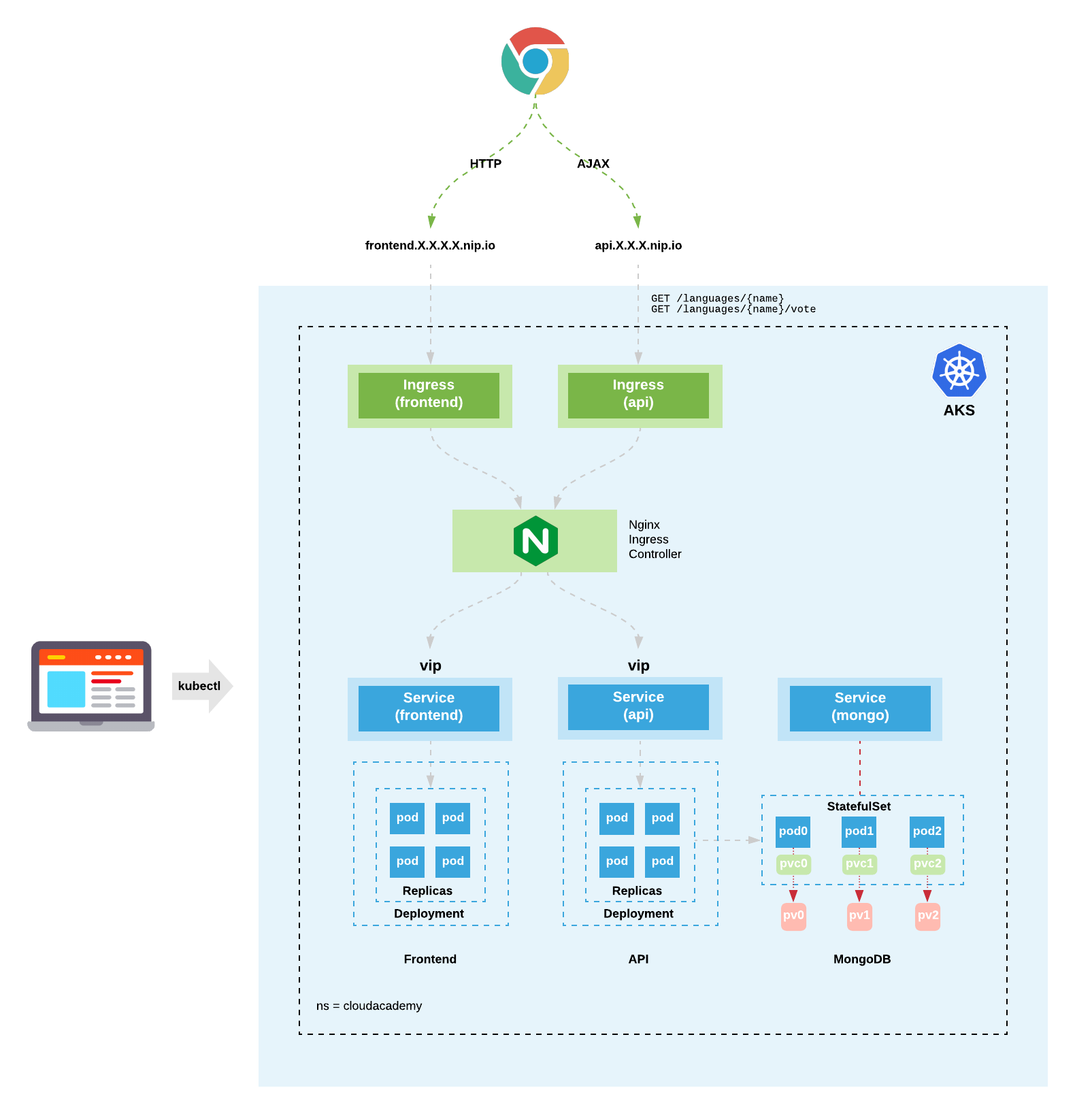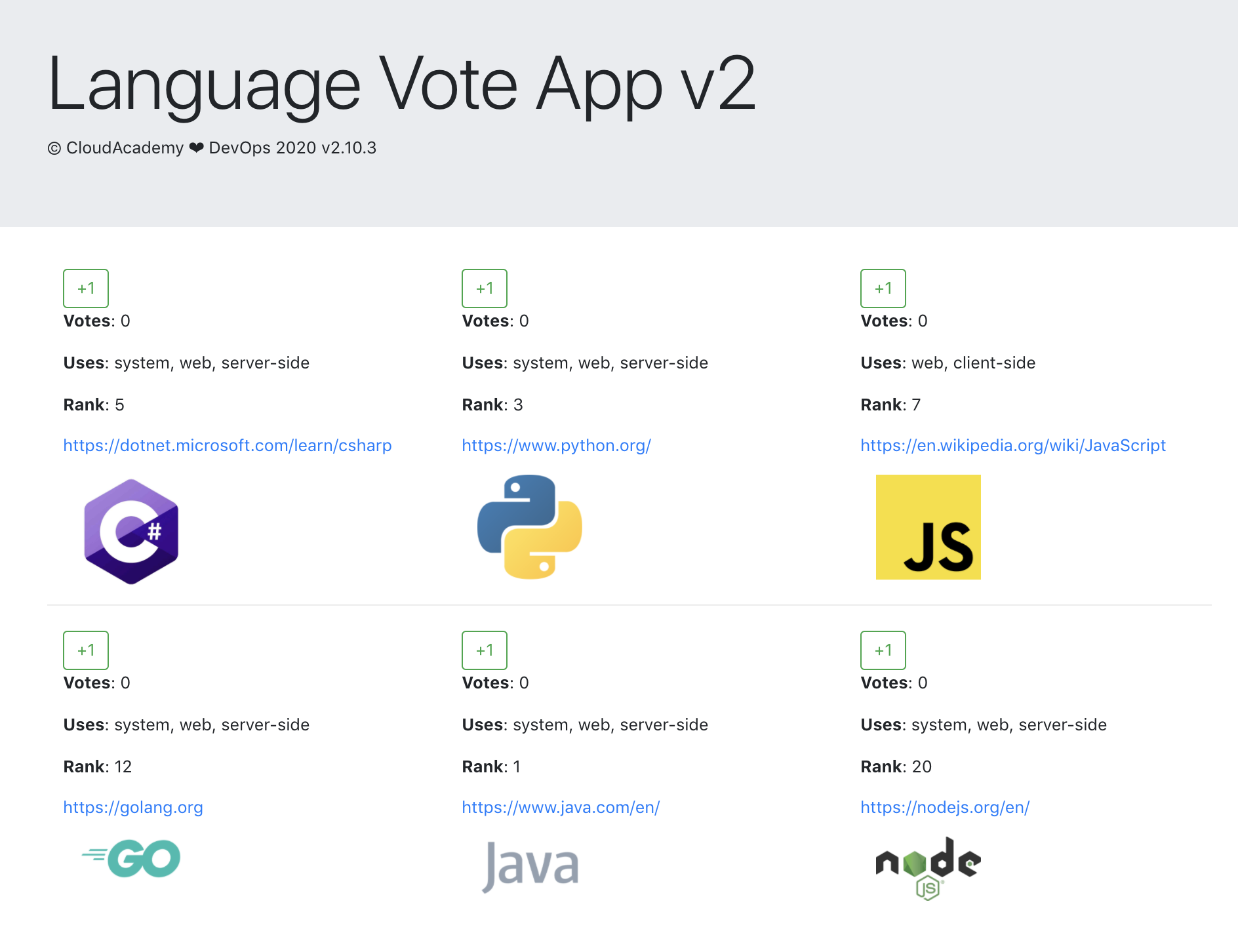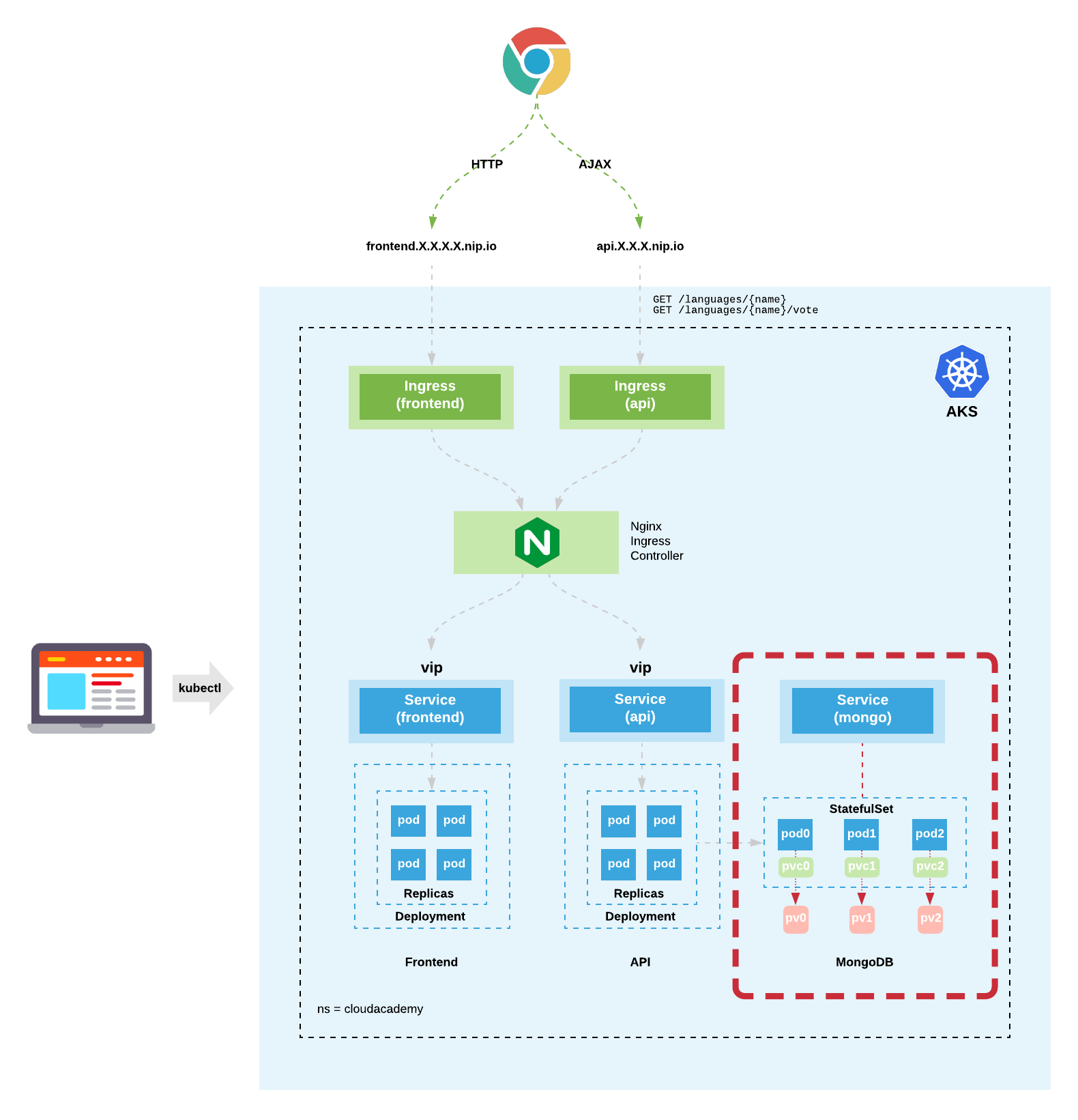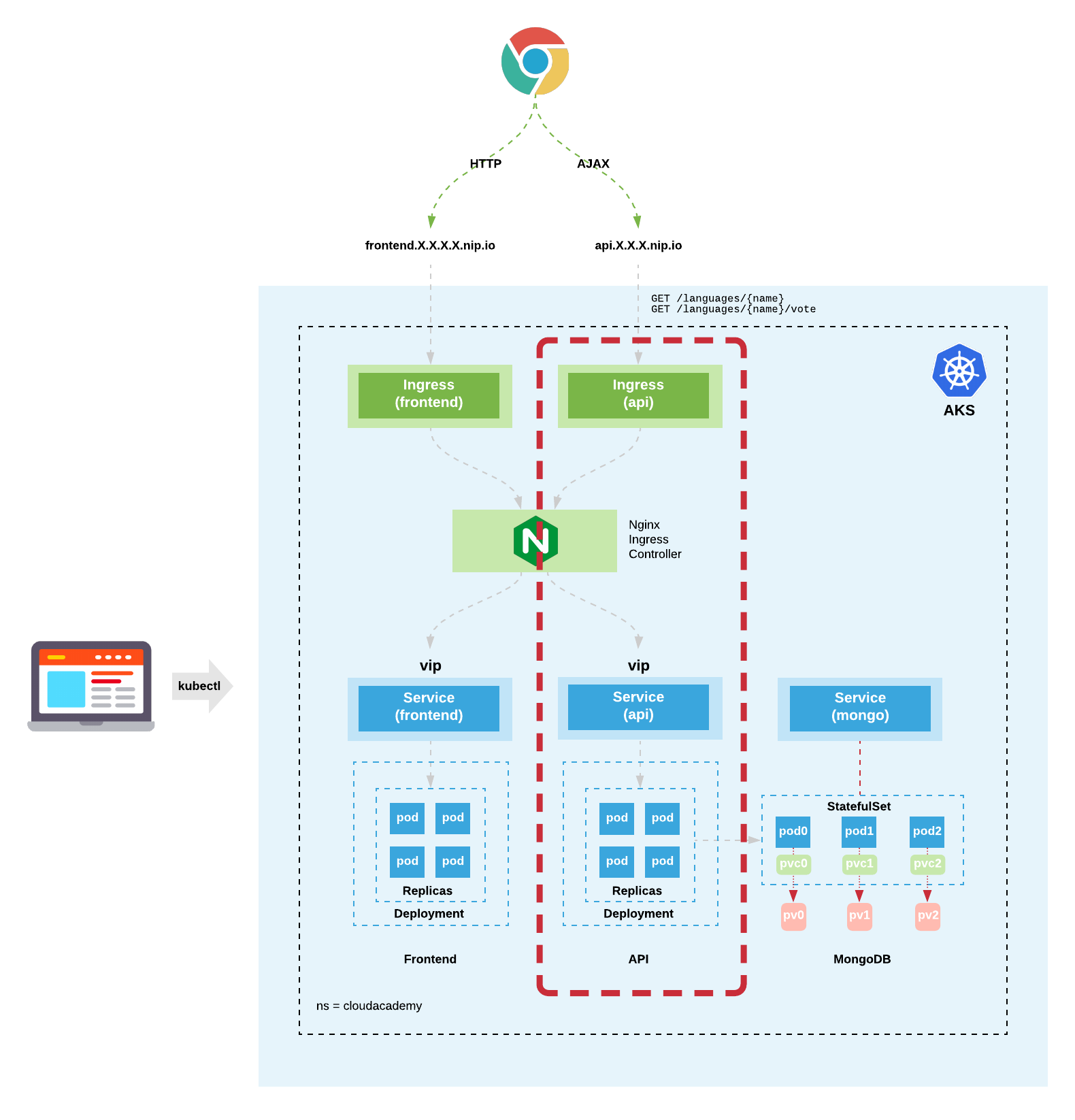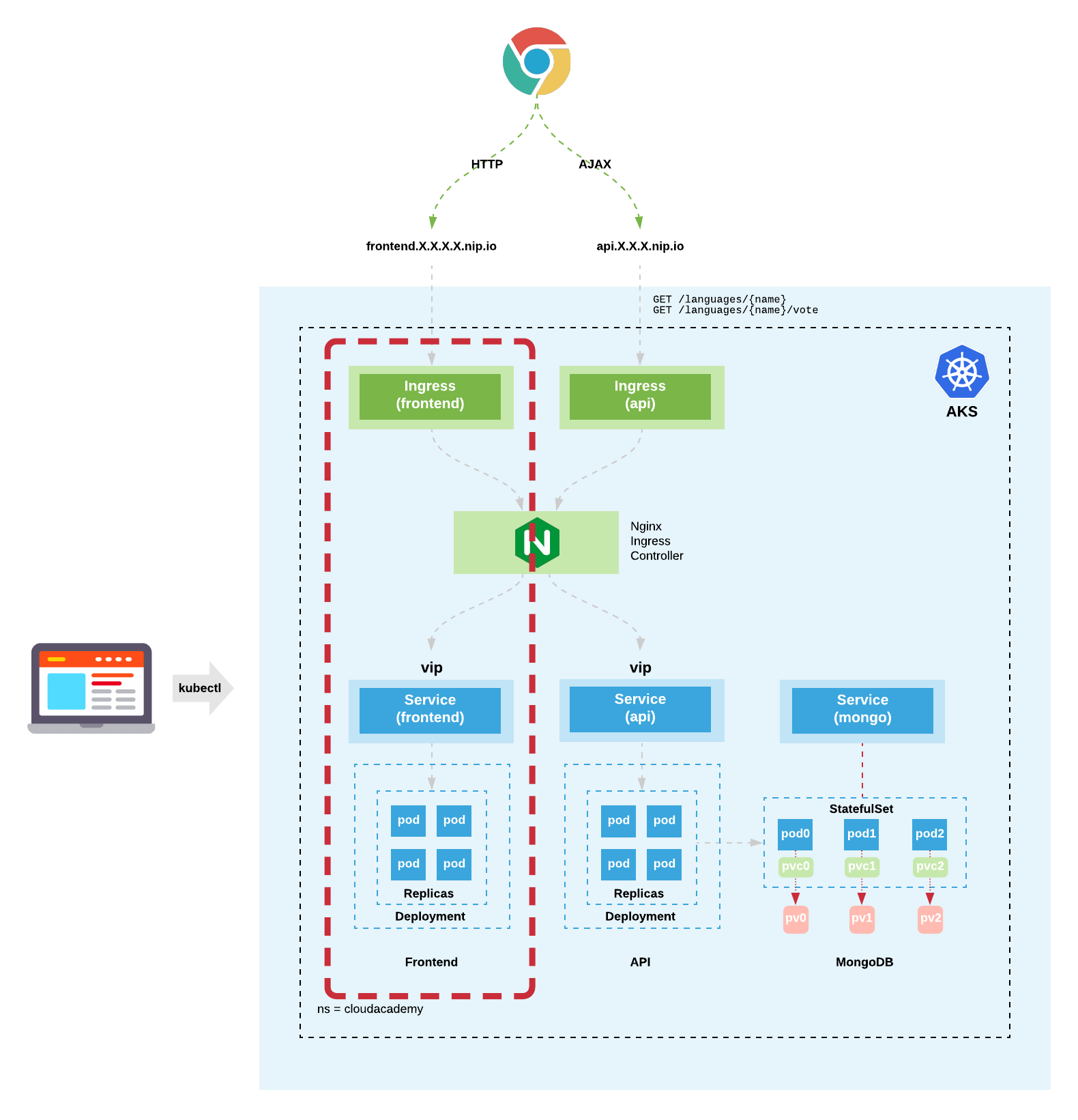The following instructions are used to demonstrate how to provision an AKS cluster on Azure and deploy a cloud native application into it.
🤘
The cloud native application is architected using microservices and is presented to the user as a web application. The application frontend provides the end-user with the ability to vote on one of 6 programming languages: C#, Python, JavaScript, Go, Java, and/or NodeJS. Voting results in AJAX calls being made from the browser to an API which in turn then saves the results into a MongoDB database.
Thu 15 Feb 2024
- Removed
--docker-bridge-addressoption onaz aks createas this has been deprecated - Corrected name of nginx svc from
aks-nginx-ingress-nginx-ingresstoaks-nginx-ingress-controller - Increased Kubernetes version to 1.27.7 to align with current Azure default
- Updated network policy selectors to use correct
podSelectorlabels for nginx - Added commands to delete the service principle
Mon 16 Jan 2023 11:57:20 NZDT
- Updated instructions and retested end-to-end
- Added instruction to create resource group
- Added
--locationparameter to commands that use it - Removed deprecated
--skip-assignmentparameter - Upgraded cluster version to 1.25.2
- Updated DNS testing to use the container image
cloudacademydevops/networkutils:v2 - Updated the Ingress resources to networking.k8s.io/v1
- Updated networkpolicy curl commands to include
--max-time 5to control connection timeout
Tue 3 Nov 2020 20:51:59 NZDT
- Updated instructions and retested end-to-end
- Upgraded cluster version to 1.18.8
- Mongo deployment now pinned down to use 4.2 to ensure replication setup initiates
- Helm nginx-ingress deployment updated
- Minor fixes to various
kubectlcommands
Tested with the following client tool versions
az2.44.1kubectl1.27.7helm3.10.3
Along the way, you'll get to see how to work with the following AKS cluster resources:
- Namespace
- Secret
- Deployment
- Service
- StatefulSet
- PersistentVolume
- PersistentVolumeClaim
- IngressController (Nginx)
- Ingress
- NetworkPolicy
Create a new AKS cluster
Authenticate the Azure CLI. In the terminal execute the following command:
az login
Define the variables used during the setup and installation:
{
CLUSTER_NAME=akstest
RESOURCE_GROUP=aks
LOCATION=westus
VNET_NAME=cloudacademy-aks-vnet
K8S_VERSION=1.27.7
}
Create new resource group.
az group create --location $LOCATION --resource-group $RESOURCE_GROUP
Create a new service principal. The AKS cluster will later be created with this.
SP=$(az ad sp create-for-rbac --name spdemocluster)
APPID=$(echo $SP | jq -r .appId)
PASSWD=$(echo $SP | jq -r .password)
echo APPID: $APPID
echo PASSWD: $PASSWD
Create a new vnet and subnet for the AKS cluster
az network vnet create \
--name $VNET_NAME \
--resource-group $RESOURCE_GROUP \
--location $LOCATION \
--address-prefixes 10.0.0.0/8 \
--subnet-name aks-subnet \
--subnet-prefix 10.240.0.0/16
Assign the contributor role to the service principal scoped on the vnet previously created
VNETID=$(az network vnet show \
--name $VNET_NAME \
--resource-group $RESOURCE_GROUP \
--query id \
-o tsv)
echo VNETID: $VNETID
az role assignment create \
--assignee $APPID \
--scope $VNETID \
--role Contributor
Create the AKS cluster and place it in the vnet subnet previously created
Standard_B2ms 1.15.10
SUBNETID=$(az network vnet subnet show \
--name aks-subnet \
--resource-group $RESOURCE_GROUP \
--vnet-name $VNET_NAME \
--query id \
-o tsv)
echo SUBNETID: $SUBNETID
az aks create \
--name $CLUSTER_NAME \
--resource-group $RESOURCE_GROUP \
--location $LOCATION \
--node-count 2 \
--node-vm-size Standard_D4s_v3 \
--vm-set-type VirtualMachineScaleSets \
--kubernetes-version $K8S_VERSION \
--network-plugin azure \
--service-cidr 10.0.0.0/16 \
--dns-service-ip 10.0.0.10 \
--vnet-subnet-id $SUBNETID \
--generate-ssh-keys \
--network-policy azure \
--service-principal $APPID \
--client-secret $PASSWD
This takes between 5-10 minutes to complete so sit back and relax, its major chill time 👍
Congrats!! You've just baked yourself a fresh AKS Kubernetes cluster!!
Test the kubectl client cluster authencation
az aks get-credentials -g $RESOURCE_GROUP --name $CLUSTER_NAME --admin
kubectl get nodes
kubectl config view
kubectl config get-contexts
kubectl config current-context
Install the Nginx Ingress Controller. This will allow us to direct inbound exteranl HTTP calls to the Frontend and API services that will be deployed into the AKS cluster.
Create the nginx-ingress namespace - holds the Nginx Ingress Controller components.
cat << EOF | kubectl apply -f -
apiVersion: v1
kind: Namespace
metadata:
name: nginx-ingress
labels:
name: nginx-ingress
EOF
Use Helm to install the Nginx Ingress Controller.
Notes:
- The
helmclient needs to be installed locally - This has beem successfully tested with
helmversion v3.10.3 - The
helmclient authenticates to the AKS cluster using the same~/.kube/configcredentials established earlier - This has beem successfully tested with the helm chart
nginx-stable/nginx-ingressversion 0.16.0 and app version 3.0.0
helm version
helm repo add nginx-stable https://helm.nginx.com/stable
helm repo update
helm search repo nginx-ingress
helm install aks-nginx-ingress nginx-stable/nginx-ingress --namespace nginx-ingress
Query the Nginx Ingress Controller and determine the public ip address that has been assigned to it.
Wait until the Nginx Ingress Controller has been allocated a public IP address
kubectl get svc aks-nginx-ingress-controller -n nginx-ingress --watch
Use Ctrl-C key sequence to exit the watch
Notes:
- The public IP address will be used to create both the API and Frontend service FQDNs used later on
- The API FQDN will be used to within the API's Ingress resource for host based path routing
- The Frontend FQDN will be used to within the Frontend's Ingress resource for host based path routing
- The https://nip.io/ dynamic DNS service is being used to provide wildcard DNS
kubectl get svc aks-nginx-ingress-controller -n nginx-ingress -o json
INGRESS_PUBLIC_IP=$(kubectl get svc aks-nginx-ingress-controller -n nginx-ingress -o=jsonpath='{.status.loadBalancer.ingress[0].ip}')
echo INGRESS_PUBLIC_IP: $INGRESS_PUBLIC_IP
API_PUBLIC_FQDN=api.$INGRESS_PUBLIC_IP.nip.io
FRONTEND_PUBLIC_FQDN=frontend.$INGRESS_PUBLIC_IP.nip.io
echo API_PUBLIC_FQDN: $API_PUBLIC_FQDN
echo FRONTEND_PUBLIC_FQDN: $FRONTEND_PUBLIC_FQDN
Create the cloudacademy namespace - holds the main sample cloud native application components
cat << EOF | kubectl apply -f -
apiVersion: v1
kind: Namespace
metadata:
name: cloudacademy
labels:
name: cloudacademy
EOF
Configure the cloudacademy namespace to be the default
kubectl config set-context --current --namespace cloudacademy
Deploy MongoDB 3 x ReplicaSet
Display the available AKS storage classes. We use the default storage class in the following MongoDb deployment.
kubectl get storageclass
Create a new Mongo StatefulSet name mongo
Note: security (--auth flag) hasn't been enabled on the MongoDb database - done to make the demonstration quicker.
cat << EOF | kubectl apply -f -
apiVersion: apps/v1
kind: StatefulSet
metadata:
name: mongo
namespace: cloudacademy
spec:
serviceName: mongo
replicas: 3
selector:
matchLabels:
role: db
template:
metadata:
labels:
role: db
env: demo
replicaset: rs0.main
spec:
affinity:
podAntiAffinity:
preferredDuringSchedulingIgnoredDuringExecution:
- weight: 100
podAffinityTerm:
labelSelector:
matchExpressions:
- key: replicaset
operator: In
values:
- rs0.main
topologyKey: kubernetes.io/hostname
terminationGracePeriodSeconds: 10
containers:
- name: mongo
image: mongo:4.2
command:
- "numactl"
- "--interleave=all"
- "mongod"
- "--wiredTigerCacheSizeGB"
- "0.1"
- "--bind_ip"
- "0.0.0.0"
- "--replSet"
- "rs0"
ports:
- containerPort: 27017
volumeMounts:
- name: mongodb-persistent-storage-claim
mountPath: /data/db
volumeClaimTemplates:
- metadata:
name: mongodb-persistent-storage-claim
spec:
accessModes:
- ReadWriteOnce
storageClassName: default
resources:
requests:
storage: 0.5Gi
EOF
Examine the Mongo Pods launch ordered sequence
kubectl get pods --watch
kubectl get pods
kubectl get pods --show-labels
kubectl get pods -l role=db
Use Ctrl-C key sequence to exit the watch
Display the MongoDB Pods, Persistent Volumes and Persistent Volume Claims
kubectl get pod,pv,pvc
Create a new Headless Service for Mongo named mongo
cat << EOF | kubectl apply -f -
apiVersion: v1
kind: Service
metadata:
name: mongo
namespace: cloudacademy
labels:
role: db
env: demo
spec:
ports:
- port: 27017
targetPort: 27017
clusterIP: None
selector:
role: db
EOF
Examine the Mongo Headless Service
kubectl get svc
Examine the DNS records for the Mongo Headless Service
kubectl run -i --tty --restart=Never --rm utils --image cloudacademydevops/networkutils:v2 -- host mongo
Examine the individual DNS records for the Mongo Headless Service
kubectl run -i --tty --restart=Never --rm utils --image cloudacademydevops/networkutils:v2 -- bash -c 'for i in {0..2}; do host mongo-$i.mongo; done'
Confirm that the mongo shell can resolve each of the 3 mongo headless service assigned dns names:
for i in {0..2}; do kubectl exec -it mongo-0 -- mongo mongo-$i.mongo --eval "print('mongo-$i.mongo succeeded')" && echo; done
On the mongo-0 pod, initialise the mongo database replica set:
cat << EOF | kubectl exec -it mongo-0 -- mongo
rs.initiate();
sleep(2000);
rs.add("mongo-1.mongo:27017");
sleep(2000);
rs.add("mongo-2.mongo:27017");
sleep(2000);
cfg = rs.conf();
cfg.members[0].host = "mongo-0.mongo:27017";
rs.reconfig(cfg, {force: true});
sleep(5000);
EOF
Confirm the mongo database replication status:
kubectl exec -it mongo-0 -- mongo --eval "rs.status()" | grep "PRIMARY\|SECONDARY"
Load the initial voting app data into the Mongo database
cat << EOF | kubectl exec -it mongo-0 -- mongo
use langdb;
db.languages.insert({"name" : "csharp", "codedetail" : { "usecase" : "system, web, server-side", "rank" : 5, "compiled" : false, "homepage" : "https://dotnet.microsoft.com/learn/csharp", "download" : "https://dotnet.microsoft.com/download/", "votes" : 0}});
db.languages.insert({"name" : "python", "codedetail" : { "usecase" : "system, web, server-side", "rank" : 3, "script" : false, "homepage" : "https://www.python.org/", "download" : "https://www.python.org/downloads/", "votes" : 0}});
db.languages.insert({"name" : "javascript", "codedetail" : { "usecase" : "web, client-side", "rank" : 7, "script" : false, "homepage" : "https://en.wikipedia.org/wiki/JavaScript", "download" : "n/a", "votes" : 0}});
db.languages.insert({"name" : "go", "codedetail" : { "usecase" : "system, web, server-side", "rank" : 12, "compiled" : true, "homepage" : "https://golang.org", "download" : "https://golang.org/dl/", "votes" : 0}});
db.languages.insert({"name" : "java", "codedetail" : { "usecase" : "system, web, server-side", "rank" : 1, "compiled" : true, "homepage" : "https://www.java.com/en/", "download" : "https://www.java.com/en/download/", "votes" : 0}});
db.languages.insert({"name" : "nodejs", "codedetail" : { "usecase" : "system, web, server-side", "rank" : 20, "script" : false, "homepage" : "https://nodejs.org/en/", "download" : "https://nodejs.org/en/download/", "votes" : 0}});
EOF
Confirm data has been loaded correctly
kubectl exec -it mongo-0 -- mongo langdb --eval "db.languages.find().pretty()"
Deploy the API consisting of a Deployment, Service, and Ingress:
Create a secret to store the mongodb connection credentials
Note: this is for demonstration purposes only - security (auth) hasn't been enabled on the MongoDb database.
The username and password values need to be base64 encode first like so
echo -n 'admin' | base64
echo -n 'password' | base64
cat << EOF | kubectl apply -f -
apiVersion: v1
kind: Secret
metadata:
name: mongodb-secret
namespace: cloudacademy
data:
username: YWRtaW4=
password: cGFzc3dvcmQ=
EOF
API: create deployment resource
cat << EOF | kubectl apply -f -
apiVersion: apps/v1
kind: Deployment
metadata:
name: api
namespace: cloudacademy
labels:
role: api
env: demo
spec:
replicas: 4
strategy:
type: RollingUpdate
rollingUpdate:
maxSurge: 1
maxUnavailable: 25%
selector:
matchLabels:
role: api
template:
metadata:
labels:
role: api
spec:
containers:
- name: api
image: cloudacademydevops/api:v2
imagePullPolicy: Always
env:
- name: MONGO_CONN_STR
value: mongodb://mongo-0.mongo,mongo-1.mongo,mongo-2.mongo:27017/langdb?replicaSet=rs0
- name: MONGO_USERNAME
valueFrom:
secretKeyRef:
name: mongodb-secret
key: username
- name: MONGO_PASSWORD
valueFrom:
secretKeyRef:
name: mongodb-secret
key: password
ports:
- containerPort: 8080
livenessProbe:
httpGet:
path: /ok
port: 8080
initialDelaySeconds: 2
periodSeconds: 5
readinessProbe:
httpGet:
path: /ok
port: 8080
initialDelaySeconds: 5
periodSeconds: 5
successThreshold: 1
EOF
API: create service resource
cat << EOF | kubectl apply -f -
apiVersion: v1
kind: Service
metadata:
name: api
namespace: cloudacademy
labels:
role: api
env: demo
spec:
ports:
- protocol: TCP
port: 8080
selector:
role: api
EOF
API: create ingress resource
cat << EOF | kubectl apply -f -
apiVersion: networking.k8s.io/v1
kind: Ingress
metadata:
name: api
namespace: cloudacademy
annotations:
nginx.ingress.kubernetes.io/rewrite-target: /
spec:
ingressClassName: nginx
rules:
- host: $API_PUBLIC_FQDN
http:
paths:
- path: /
pathType: Prefix
backend:
service:
name: api
port:
number: 8080
EOF
- Examine the rollout of the API deployment
- Examine the pods to confirm that they are up and running
- Examine the API pod log to see that it has successfully connected to the MongoDB replicaset
- Examine the API service details
kubectl rollout status deployment api
kubectl get pods
kubectl get pods -l role=api
kubectl logs <API_POD_NAME_HERE>
kubectl get svc
Test the API route url - test the /ok, /languages, and /languages/{name} endpoints
curl -s $API_PUBLIC_FQDN/ok
Note: The following commands leverage the jq utility to format the json data responses
curl -s $API_PUBLIC_FQDN/languages | jq .
curl -s $API_PUBLIC_FQDN/languages/go | jq .
curl -s $API_PUBLIC_FQDN/languages/java | jq .
curl -s $API_PUBLIC_FQDN/languages/nodejs | jq .
Create a new frontend Deployment
Notes:
- The value stored in the
$API_PUBLIC_FQDNvariable is injected into the frontend container'sREACT_APP_APIHOSTPORTenvironment var - this tells the frontend where to send browser initiated API AJAX calls
Frontend: create deployment resource
cat << EOF | kubectl apply -f -
apiVersion: apps/v1
kind: Deployment
metadata:
name: frontend
namespace: cloudacademy
labels:
role: frontend
env: demo
spec:
replicas: 4
strategy:
type: RollingUpdate
rollingUpdate:
maxSurge: 1
maxUnavailable: 25%
selector:
matchLabels:
role: frontend
template:
metadata:
labels:
role: frontend
spec:
containers:
- name: frontend
image: cloudacademydevops/frontend:v10
imagePullPolicy: Always
env:
- name: REACT_APP_APIHOSTPORT
value: $API_PUBLIC_FQDN
ports:
- containerPort: 8080
livenessProbe:
httpGet:
path: /ok
port: 8080
initialDelaySeconds: 2
periodSeconds: 5
readinessProbe:
httpGet:
path: /ok
port: 8080
initialDelaySeconds: 5
periodSeconds: 5
successThreshold: 1
EOF
Frontend: create service resource
cat << EOF | kubectl apply -f -
apiVersion: v1
kind: Service
metadata:
name: frontend
namespace: cloudacademy
labels:
role: frontend
env: demo
spec:
ports:
- protocol: TCP
port: 8080
selector:
role: frontend
EOF
Frontend: create ingress resource
cat << EOF | kubectl apply -f -
apiVersion: networking.k8s.io/v1
kind: Ingress
metadata:
name: frontend
namespace: cloudacademy
annotations:
nginx.ingress.kubernetes.io/rewrite-target: /
spec:
ingressClassName: nginx
rules:
- host: $FRONTEND_PUBLIC_FQDN
http:
paths:
- path: /
pathType: Prefix
backend:
service:
name: frontend
port:
number: 8080
EOF
Examine the rollout of the Frontend Deployment
kubectl rollout status deployment frontend
kubectl get pods
kubectl get pods -l role=frontend
Use the curl command to test the application via the frontend route url
curl -s -I $FRONTEND_PUBLIC_FQDN
curl -s -i $FRONTEND_PUBLIC_FQDN
Generate the frontend URL
echo http://$FRONTEND_PUBLIC_FQDN
Now test the full end-to-end application using the Chrome browser...
Note: Use the Developer Tools within the Chrome browser to record, filter, and observe the AJAX traffic (XHR) which is generated when any of the +1 vote buttons are clicked.
Query the MongoDb database directly to observe the updated vote data.
kubectl exec -it mongo-0 -- mongo langdb --eval "db.languages.find().pretty()"
Setup and install Network Policies to control pod-to-pod traffic
Default deny all network policy for pod-to-pod traffic within the cloudacademy namespace
cat << EOF | kubectl apply -f -
apiVersion: networking.k8s.io/v1
kind: NetworkPolicy
metadata:
name: default-deny-all
namespace: cloudacademy
spec:
podSelector: {}
policyTypes:
- Ingress
EOF
Test to confirm that the frontend traffic path is now blocked
curl -vv -i --max-time 5 $FRONTEND_PUBLIC_FQDN
Allow mongo-to-mongo pod traffic, required for MongoDb data replication
cat << EOF | kubectl apply -f -
kind: NetworkPolicy
apiVersion: networking.k8s.io/v1
metadata:
name: allow-from-mongo-to-mongo
namespace: cloudacademy
spec:
podSelector:
matchLabels:
role: db
ingress:
- from:
- podSelector:
matchLabels:
role: db
EOF
Allow api-to-mongo pod traffic, required to allow the API to read/write data into the MongoDb database
cat << EOF | kubectl apply -f -
kind: NetworkPolicy
apiVersion: networking.k8s.io/v1
metadata:
name: allow-from-api-to-mongo
namespace: cloudacademy
spec:
podSelector:
matchLabels:
role: db
ingress:
- from:
- podSelector:
matchLabels:
role: api
EOF
Allow ingress-to-api pod traffic, required to allow API ajax calls from the browser
cat << EOF | kubectl apply -f -
kind: NetworkPolicy
apiVersion: networking.k8s.io/v1
metadata:
name: allow-from-ingress-to-api
namespace: cloudacademy
spec:
podSelector:
matchLabels:
role: api
ingress:
- from:
- podSelector:
matchLabels:
app.kubernetes.io/instance: aks-nginx-ingress
namespaceSelector:
matchLabels:
name: nginx-ingress
EOF
Allow ingress-to-frontend pod traffic, required to allow the frontend (html, js, css) to be requested by the browser
cat << EOF | kubectl apply -f -
kind: NetworkPolicy
apiVersion: networking.k8s.io/v1
metadata:
name: allow-from-ingress-to-frontend
namespace: cloudacademy
spec:
podSelector:
matchLabels:
role: frontend
ingress:
- from:
- podSelector:
matchLabels:
app.kubernetes.io/instance: aks-nginx-ingress
namespaceSelector:
matchLabels:
name: nginx-ingress
EOF
Allow ingress-to-kube-dns from pod traffic in cloudacademy namespace, required to allow pod dns traffic to resolve
cat << EOF | kubectl apply -f -
kind: NetworkPolicy
apiVersion: networking.k8s.io/v1
metadata:
name: allow-from-cloudacademy-ns-to-kube-dns
namespace: kube-system
spec:
podSelector:
matchLabels:
k8s-app: kube-dns
ingress:
- from:
- namespaceSelector:
matchLabels:
name: cloudacademy
EOF
Test to confirm that the frontend traffic path is now repaired and working
curl -vv -i --max-time 5 $FRONTEND_PUBLIC_FQDN
Test the application again within the browser and generate some voting traffic
Query the MongoDb database directly to observe the updated vote data
kubectl exec -it mongo-0 -- mongo langdb --eval "db.languages.find().pretty()"
When you've finished with the AKS cluster and no longer need it tear it down to avoid ongoing charges!!
az aks delete --name $CLUSTER_NAME -g $RESOURCE_GROUP
Find the ID of the spdemocluster service principle we created earlier, and delete it:
sp_id=$(az ad sp list --display-name spdemocluster --query "[0].id" -o tsv)
echo sp_id=$sp_id
az ad sp delete --id $sp_id
app_id=$(az ad app list --display-name spdemocluster --query "[0].id" -o tsv)
echo app_id=$app_id
az ad app delete --id $app_id
Good luck with your AKS adventures!!
🚀
